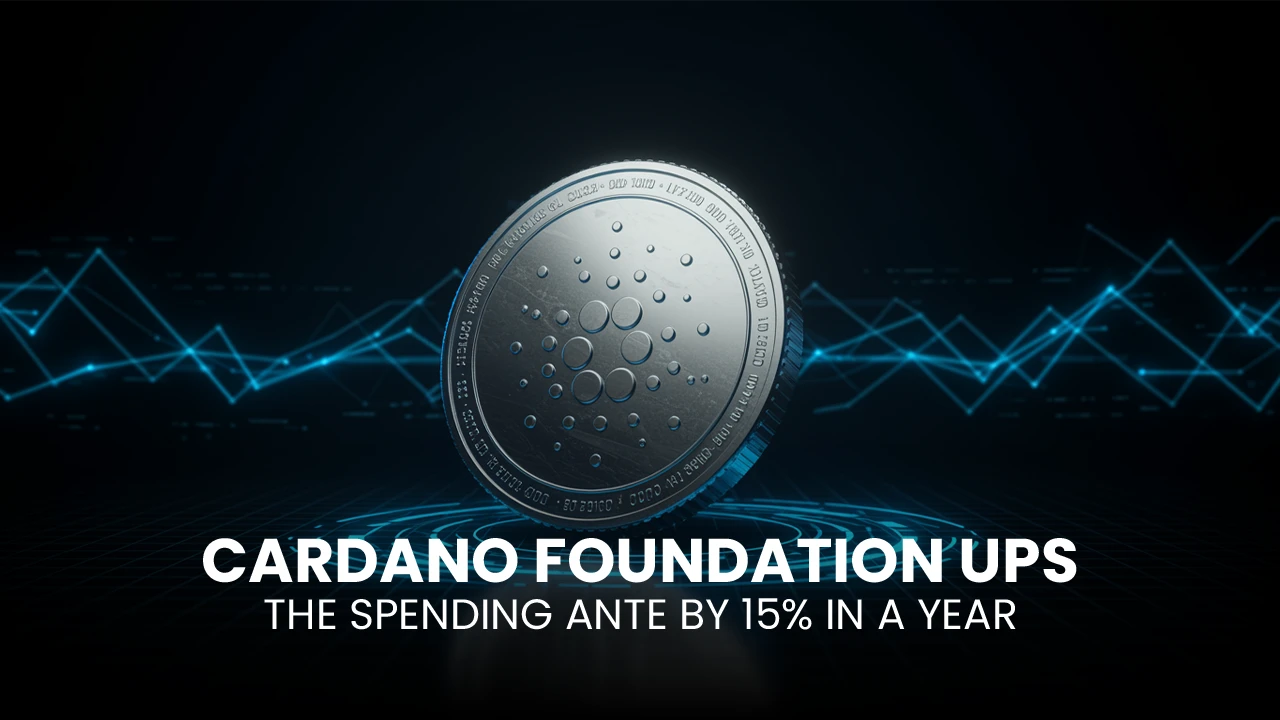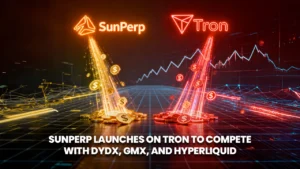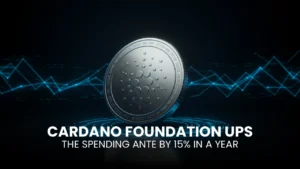Cardano Foundation Ups the Spending Ante by 15% in a Year: What It Means for Blockchain’s Future

The crypto world rarely stops to breathe. Yet in 2025, the Cardano Foundation did more than just keep pace; it doubled down. A 15% rise in yearly expenditure marked a turning point, elevating its total spend to $22.1 million. With the blockchain sector still navigating regulatory uncertainty, this strategic increase underlines a focused attempt to entrench Cardano deeper into real-world applications.
According to the Cardano Foundation’s latest financial report, released via its blockchain-native Reeve tool, the increased budget was channeled into three core areas: adoption, operational resilience, and education. These aren’t just buzzwords. They represent a trifecta essential for long-term blockchain viability, especially as governments and institutions inch closer to on-chain integration.
Real-World Adoption Gets the Lion’s Share
Over $15 million—nearly 70% of the annual budget—was poured into adoption initiatives. These efforts extended beyond the confines of crypto-native spaces. Strategic collaborations with legacy entities such as NASA and the United Nations Development Programme turned heads across both crypto and traditional sectors. Cardano Foundation’s partnership with a major European football club also signals a shift in how blockchain projects market utility to mainstream audiences.
This isn’t merely a play for headlines. These collaborations aim to develop usable, scalable blockchain tools. The integration of Cardano’s tech into humanitarian missions, global data systems, and sports ecosystems indicates that the foundation is focusing on real-world traction over hype-driven growth.
Cardano Foundation’s push toward real-world adoption establishes experience and expertise across diverse domains. According to a report, these collaborations aim to align blockchain tech with measurable outcomes.
Notably, Cardano operates on a Delegated Proof-of-Stake (DPoS) consensus mechanism. This model relies on token holders delegating their ADA to validators who secure the network, a method that reinforces scalability and energy efficiency, crucial for supporting real-world applications.
Operational Resilience Takes a New Shape
To build a durable blockchain ecosystem, technical stability and interoperability must be prioritized. Cardano Foundation allocated $3.8 million to operational resilience, and this spending went beyond system upgrades. One notable move was the launch of a fully open-source Cardano.org platform. Transparency has long been a pillar in blockchain culture, and this platform reinforces that ethos.
Another major development was the Inter-Blockchain Communication Protocol (IBC), allowing Cardano to connect with over 115 blockchains. That’s no small feat. As cross-chain compatibility becomes the standard rather than a luxury, Cardano’s proactive approach places it among the frontrunners. This development is expected to strengthen ADA’s utility and position in the broader crypto economy.
Such interoperability could lead to new use cases in decentralized finance (DeFi), supply chain systems, and national identity programs. In the eyes of developers and analysts, this is a play that improves infrastructure while keeping Cardano competitive.
Cardano’s DPoS consensus mechanism plays a central role in maintaining this resilience. Validators chosen through ADA delegations help keep the network robust while reducing energy consumption compared to Proof-of-Work systems.
Education Remains the Silent Powerhouse
Blockchain isn’t easy to understand for most people. The Cardano Foundation recognizes that true adoption hinges on knowledge. That’s why a portion of its 2024 budget was allocated to education initiatives, including workshops, developer programs, and community courses.
Unlike marketing campaigns or flashy token launches, educational investments rarely make headlines. Yet they are crucial for community growth and protocol security. The more developers understand how Cardano works, the more applications they can build on it. And the better users understand ADA, the more responsibly they interact with the network.
With over 100 full-time employees by year-end, the foundation’s growing human capital also strengthens this educational drive. It ensures that Cardano isn’t just building tech, it’s building the talent to support and sustain it.
Education efforts also emphasize the workings of Cardano’s Delegated Proof-of-Stake model. By understanding how delegation influences validator selection, stakeholders gain deeper control over how the network evolves.
A Snapshot of Cardano’s Growing War Chest
As of the end of 2024, the Cardano Foundation held $659.1 million in assets. This marks a significant increase from $478.24 million the previous year, reflecting the positive momentum in crypto markets. Interestingly, while ADA remains the dominant holding (76.7%), the foundation has diversified. BTC now comprises 15% of its portfolio, while 8.3% is in cash equivalents.
The Cardano Foundation’s primary income source, staking, earned it 17.1 million ADA in 2024 alone, representing a 2.7% yield from its 599.2 million ADA holdings. This passive income strengthens its sustainability model, ensuring that ecosystem investments don’t rely on external funding or token sales.
That staking yield is rooted in the DPoS system, where ADA holders delegate their stake to validators. It’s not just a revenue model—it’s part of the network’s backbone, maintaining decentralization and incentivizing active participation.
South America: A Rising Frontier for Cardano?
The South American crypto landscape is evolving fast. Countries like Argentina, Brazil, and Colombia are increasingly exploring blockchain for remittances, inflation hedging, and cross-border payments. For a project like Cardano Foundation, which is both delegated proof-of-stake and community-oriented, this region presents fertile ground.
Analysts are optimistic. With Cardano Foundation’s increasing focus on social impact and decentralized identity solutions, Latin America could serve as a proving ground. Analysts tracking Solana’s explosive growth in the region have noted how retail adoption often outpaces institutional action. Cardano’s educational investments and real-world use cases may position it favorably for similar organic growth.
ALSO READ: Ark Chief Offloads $47.9 Million in Crypto Stock Amid Bitcoin’s Record-Breaking Rally
It’s worth noting that ADA’s modest 42% price gain in 2024 still lagged behind BTC’s 120% surge. Yet that slower growth might reflect a more measured, utility-based strategy, one that prioritizes ecosystem fundamentals over speculation.
Governance That Mirrors Responsibility
One of the most underrated aspects of the Cardano Foundation’s performance is its governance. The delegation of ADA staking to stake pools that contribute to the ecosystem—rather than simply to maximize yield—illustrates a values-driven approach.
This contrasts with the actions of some foundations that chase staking rewards without considering the long-term impact. Cardano’s model incentivizes good actors and penalizes those who don’t add value. In a decentralized infrastructure, these subtle decisions determine whether a network thrives or withers.
Cardano Foundation’s long-term vision of decentralized governance continues to mature. As more of its treasury is invested in core areas and transparently reported, it sets a benchmark for how L1 foundations can operate with both transparency and impact.
At the heart of this governance structure lies the DPoS mechanism. It empowers ADA holders to shape validator dynamics and ensures the network remains both participatory and secure.
Final Thoughts: Trust Is the True Asset
Crypto markets thrive on narratives. But when the hype dies down, trust remains the core currency. With a 15% rise in spending, strategic real-world collaborations, and measured financial growth, the Cardano Foundation seems to understand this.
For financial analysts, this signals maturity. For developers, it signals opportunity. And for crypto newcomers, it shows that blockchain isn’t just about flipping coins—it’s about building infrastructure for decades to come.
Glossary
Cardano Foundation: A non-profit organization that manages and develops the Cardano blockchain.
ADA: The native cryptocurrency of the Cardano blockchain.
Inter-Blockchain Communication (IBC): A protocol allowing different blockchains to interact.
Staking: Locking up cryptocurrency to support network operations and earn rewards.
Delegation: Assigning one’s staking power to a validator or pool.
Operational Resilience: The ability of a blockchain to maintain its function despite challenges.
Adoption: Real-world use and implementation of blockchain technology.
Open Source: Software with publicly accessible code.
Utility Token: A token used for accessing features on a blockchain.
Decentralized Governance: A system where control is distributed among network participants.
Delegated Proof-of-Stake (DPoS): A consensus mechanism where users delegate their stake to validators who maintain the network.
FAQs
- What is the Cardano Foundation’s primary goal? The foundation aims to support the growth, adoption, and governance of the Cardano blockchain.
- How does Cardano’s spending benefit users? Increased spending supports network upgrades, education, and real-world adoption, improving the ecosystem for developers and token holders.
- Why is ADA a significant part of the foundation’s portfolio? As the native token, ADA supports network operations and yields staking rewards that fund ongoing activities.
- What makes Cardano’s governance model different? Cardano’s staking delegation strategy emphasizes ecosystem contribution over pure profit, promoting sustainability.
- Is Cardano expanding in South America? Yes. With increasing blockchain use in Latin America, Cardano’s education and ID solutions are well-suited for this growing market.
- How does the foundation earn income? Through ADA staking rewards, which generated 17.1 million ADA in 2024 alone.
- What is the Inter-Blockchain Communication Protocol? It enables Cardano to connect with 115+ blockchains, enhancing interoperability and use cases.




